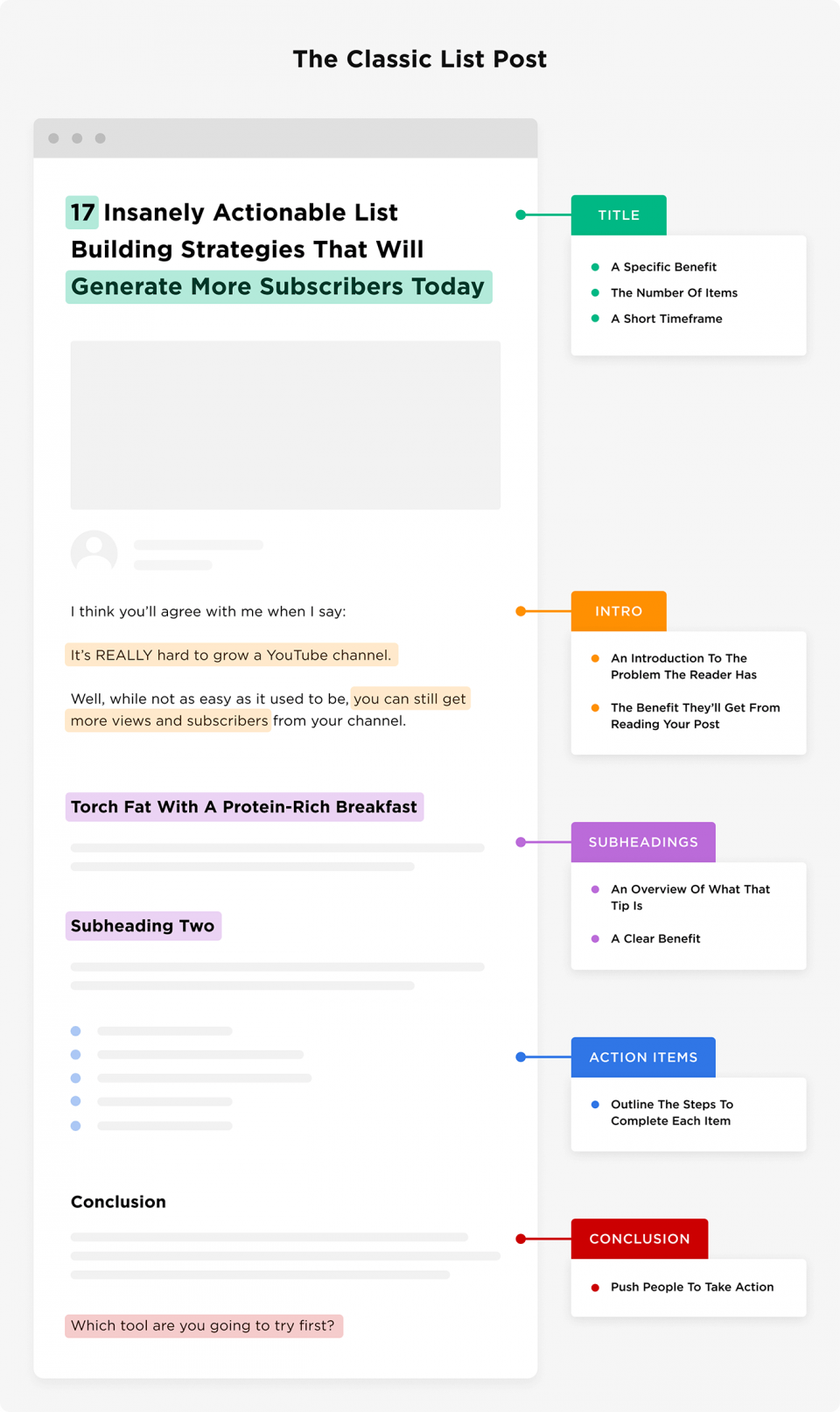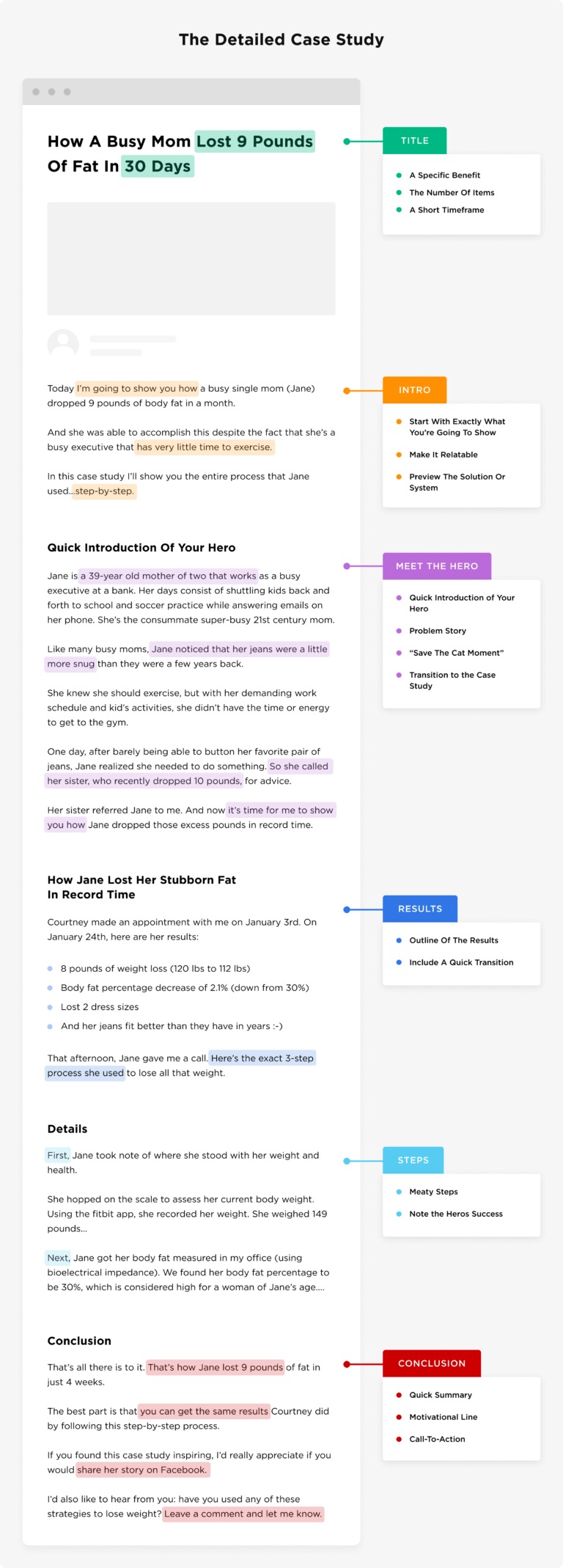列表文章 classic-list-post

classic-list-post 经典列表式文章
List Post Title 列表是文章标题
你的列表是文章标题,需要有以下三个因素:
-
A benefit-一个好处
-
The number of items 数字
-
A short timeframe 一个很短的时间框架
First, you need to state the benefit that someone will get out of reading your post. There’s no need to be overly creative here. Simply name the benefit. 首先你需要陈述一个别人通过阅读你的文章可以获得的好处,没有必要太过花哨,简单的说出好处的名字就行。
Example: 17 Insanely Actionable List Building Strategies That Will Generate More Subscribers Today (The benefit is: “will generate more subscribers”). 例如:17 个可操作的列表构建策略,今天将带来更多订阅者(好处就是:将会带来更多粉丝)
Next, you need the number of items on your list. If possible, start your title off with that number.接下来你需要这个列表的数字,如果可能,请以该数字开头。
Example: 22 Things You Can Do Today to Change Your Photography Forever 例如:22 个你立即可以上手并永远改变你拍摄技巧的方法
Finally, you want to demonstrate a specific time frame that shows how actionable your content is. People love strategies they can implement right away. 最后,您想展示一个特定的时间范围,以显示您的内容的可操作性。人们喜欢他们可以立即实施的策略。
Example: 24 Quick Actions You Can Do Today That Can Change Your Financial Life Forever 例如 22 个可以立即上手并彻底改变财务状况的方法。
List Post Introduction 列表文章介绍
Your list post introduction has two parts: 你的列表是文章介绍有两部分
-
An introduction to the problem the reader has 读者的问题介绍
-
The benefit they’ll get from reading your post 通过阅读你的文章可以带来的好处
First, you quickly (and I mean quickly) introduce the problem that the items on your list will help them solve.首先你快速介绍问题,并且接下来的方法可以帮他们解决。
Example: I think you’ll agree with me when I say:例如:当我这样说,我相信你肯定会非常同意我的看法
It’s REALLY hard to grow a YouTube channel.现在通过 YouTube 频道获取粉丝真的是非常困难
Second, (quickly!) introduce the benefit that your list post will help them achieve.第 2 步,快速介绍你可以帮助他们解决问题的好处
Good Example:一个好的例子
Well, while not as easy as it used to be, you can still get more views and subscribers from your channel.好吧,虽然不像以前那么容易,但您仍然可以从您的频道获得更多观看次数和订阅者。
Pro Tip: Don’t forget to really emphasize that your content will help solve the reader’s problem. The more clear that is, the more likely they are to read on.专业提示:不要忘记真正强调您的内容将有助于解决读者的问题。越清楚,他们就越有可能继续阅读。
List Post Subheadings
Subheadings are HUGE.
First, they break your content up into manageable chunks.
Second, when you make your subheaders benefit-rich, it boosts the perceived value of your content.
So each of your subheadings should contain two things:
-
An overview of what that tip is
-
A clear benefit
When people see items that will help them lose weight, eat better or make more money, they’re more likely to share it.
Good Example: Torch Fat With a Protein-Rich Breakfast.用富含蛋白质的早餐燃烧脂肪。
Bad Example: Eat Protein at Breakfast 坏例子:早餐吃蛋白质
Good Example #2: Save $200/Month on Car Insurance With One Phone Call 只需一个电话,每月可节省 200 美元的汽车保险费用
Bad Example #2: Save Money on Car Insurance 省钱买汽车保险
See the difference?
Pro Tip: Make sure you start your ELP off with your best tip. This will hook people for the rest of the post. 确保以最好的提示开始您的 ELP。这将吸引人们阅读帖子的其余部分。
List Post Action Items
Now it’s time to outline the steps someone will need to complete each item on the list.
Pro Tip: Include photos, screenshots, real-life examples or even video tutorials. The more visuals you include, the easier it will be for your reader to follow the steps.
List Post Conclusion
Now it’s time to wrap things up.
You want your list post conclusions to do one thing: Push people to take action.
When someone gets results from your content, they become a fan for life.

Pro Tip: Ask your reader to leave a comment. Have them publicly commit to taking action. For example, “Let me know the 1 item on this list you’re going to take action on first.”
案例研究 detail case study

文案写作类型-详细案例研究
Case Study Title
To get the most clicks and attention to your case study, your headline should contain 3 elements:
Specific Benefit
First, state the benefits that the “hero” of your case study saw. The more specific, the better.
Example: “How a Busy Mom Lost 9 Pounds of Fat in 30 days”
A number
Second, you want to include at least one number. This number adds credibility to your case study by showing you have actual data behind your content.
Example: “Link Building Case Study: How I Increased My Search Traffic by 110% in 14 Days”
Timeframe
Finally, specify how long it took to see those benefits. The shorter the time frame the better.
Good Example: “From Geek to Freak: How I Gained 34 lbs. of Muscle in 4 Weeks”
Pro Tip: Don’t be afraid to write about modest results in your case study. In fact, modest results are usually BETTER than uber-impressive results. Why? Because they’re more relatable. In other words, a case study of someone losing 10 pounds is often more compelling than one that describes how someone lost 100 pounds.
Case Study Introduction
Here’s what you include in your case study introduction:
First, start your intro off with EXACTLY what you’re going to show them in the case study. As the old journalism saying goes: “Don’t bury the lead”. ?
Example: “Today I’m going to show you how a busy single mom (Jane) dropped 9 pounds of body fat in a month.”
Next, break down some of the things that make you, your client, friend, or customer relatable.
Example: “And she was able to accomplish this despite the fact that she’s a busy executive that has very little time to exercise.”
Finally, preview the solution or system that was used to get this benefit. Then mention you’ll outline how they did it in detail.
Example: “In this case study I’ll show you the entire process that Jane used… step-by-step.”
Meet The Hero Section
The “Meet The Hero” section is where you introduce the hero of your case study. This section is important because it helps your reader connect with your hero and put themselves in your hero’s shoes.
Quick Introduction of Your Hero
Example: “Jane is a 39-year old mother of two that works as a busy executive at a bank. Her days consist of shuttling kids back and forth to school and soccer practice while answering emails on her phone. She’s the consummate super-busy 21st century mom.”
Problem Story
Example: “Like many busy moms, Jane noticed that her jeans were a little more snug than they were a few years back.
She knew she should exercise, but with her demanding work schedule and kid’s activities, she didn’t have the time or energy to get to the gym.”
“Save The Cat Moment”
The term “Save The Cat” comes from the screenwriting classic, Save The Cat. It’s a small detail that makes your hero more human and relatable.
Good Example: “One day, after barely being able to button her favorite pair of jeans, Jane realized she needed to do something. So she called her sister, who recently dropped 10 pounds, for advice.”
Transition to the Case Study
Good Example: “Her sister referred Jane to me. And now it’s time for me to show you how Jane dropped those excess pounds in record time.”
Results Section
At this point your reader is anxious to see how they did it. But before diving into the steps, whet their appetite with a quick overview of your hero’s results.
Your Results Section subheading should reiterate your hero’s results.
Example: “How I Boosted My Conversion Rate by 73.4% (Without A/B Testing)”
Here’s what to include in this section:
First, quickly outline of the results that your Hero achieved.
Example: “Courtney made an appointment with me on January 3rd. On January 24th, here are her results:
-
8 pounds of weight loss (120 lbs to 112 lbs)
-
Body fat percentage decrease of 2.1% (down from 30%)
-
Lost 2 dress sizes
-
And her jeans fit better than they have in years :-)”
Next, include a quick transition to the meat of your case study. This helps the reader understand the story is over and that it’s time to get into the meat of the content.
Example: “That afternoon, Jane gave me a call. Here’s the exact 3-step process she used to lose all that weight.”
Steps Section
Now it’s time to get into the meaty details of your case study. Many case studies are big on hype and short on details.
That’s why this section is so important. The detailed steps will make your case study stand out.
And here’s where you list the steps your hero used to make progress on Step #1. No detail is too small. Don’t be afraid to tell them EXACTLY what to do.